How To Upload Movies To Ipad Pro
Some new Apple products have a whiff of "finally" about them. The new MacBook Air, with modern accoutrements such as a Retina display along with an first-class keyboard and a respectable 256GB of storage, for $999? Finally!
The new iPad Pro, however, is the furthest thing possible from a "finally" product. After all, the previous iPad Pro, which shipped in November 2018, is hardly an antique. In fact, it's and then capable that its operating organisation, iPadOS, is nevertheless playing take hold of-upwards with the hardware's potential.
Still, just a little more than 16 months after that machine's inflow, Apple is back with another new iPad Pro. It's an incremental upgrade to its meaty predecessor, which trimmed down the tablet's bezels, souped up its processor, incorporated Face ID and USB-C, and added ultra-clever magnetic inductive charging for a new version of the Pencil stylus. This time effectually, Apple gave the iPad Pro another performance heave and substantially upgraded its photographic camera organisation. In a first for an Apple tree product, information technology also built in a lidar scanner for augmented reality distance-measuring.
Judged on its existing and new merits, this tablet is a highly evolved delight. Merely if you already have the 2018 iPad Pro, you lot would need to be awfully serious about tablet photography and/or AR to discover it a compelling upgrade, at prices that outset at $799 for the 11″ model and $999 for its 12.9″ big brother.
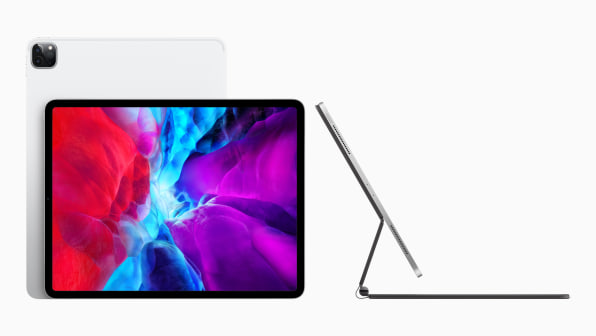
Hold on, though. In May, Apple tree plans to release an accessory that may have more bear upon on the way people use an iPad than the new version of the tablet itself will—and it's uniform with both the 2020 and 2018 models. The Magic Keyboard instance will give the iPad Pro a laptop-quotient backlit keyboard and trackpad, along with the ability to swivel the tablet to the angle of your choice and charge information technology without commandeering its USB-C port. For those willing to pay the price ($299 for the 11″ version, $349 for 12.9″), it looks like a productivity game changer. (Lower-end iPads volition get cheaper, less extravagantly innovative keyboard/trackpad cases from Logitech.)
For the by week, I've been living with a new 12.9″ iPad Pro provided past Apple. I used information technology with the $129 Pencil and $199 Smart Keyboard Folio (an existing keyboard example available in a slightly updated version) to perform tasks such as writing this article. I also tried iPadOS's new cursor back up by using Apple'southward Magic Trackpad. As someone who's spent—this is a bourgeois guesstimate—ii,500 hours working on a 2018 iPad Pro, the new one largely felt like the old i. Mostly, I felt similar I was priming myself for the era that will begin once the iPad Pro and Magic Keyboard bring the about laptop-similar iPad experience still.
Congenital for pros
In the early days of the iPad, earlier Apple started taking the device's cameras seriously, it was pretty much conventional wisdom that shooting photos and video with a tablet was non only a bad idea merely kind of embarrassing. Today, iPad photography may remain a niche activeness. In a wholly unscientific Twitter poll, I asked iPad users how much they used the rear camera: Simply 3% reported doing so "ofttimes." Thirteen percent said they used it "sometimes" and a whopping 80% said "never or almost never."
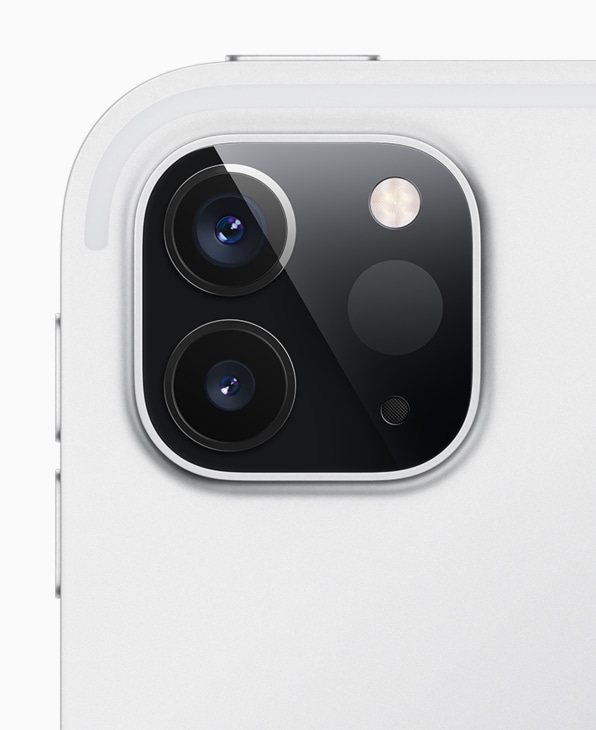
Using an iPad Pro equally a photographic camera in the manner we utilise smartphones as our constant photographic companions notwithstanding isn't fun; at a pound and up, they're too unwieldy. And did I mention you can't stick one in your pocket?
But even Apple isn't positioning the tablet as a snapshot taker. Instead, it sees a market for the iPad Pro among filmmakers, YouTubers, and other creatives for whom the tablet can be an all-in-i studio in a manner that even a powerful MacBook Pro is not. With that in mind, it added an ultra-wide camera (complementing the existing wide-angle one) and 4K video shooting, matching features available with the iPhone xi. It also upgraded the tablet'southward 5 microphones to "studio quality" units designed to pick up sound meliorate in tricky situations, which will benefit even not-and then-pro experiences such as FaceTime calls and Zoom conferences.
Along with these audio/visual upgrades, the new iPad Pro sports Apple's new eight-core A12Z Bionic processor. It's non a dramatic accelerate on the old model'south A12X. When I ran the GeekBench 5 benchmark on the previous and new tablets, the CPU scores were a wash: effectually i,100 in both cases. In the compute (GPU) tests, the new iPad Pro got a score of about 10,000, 16% faster than the before model's score of 8600.
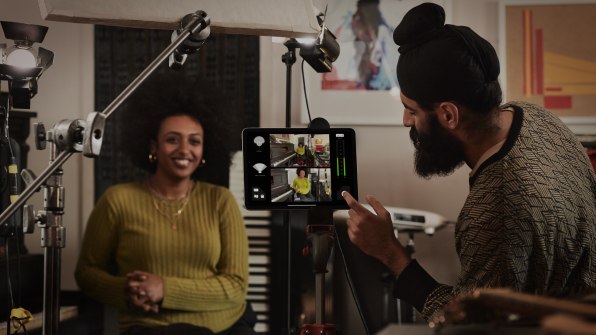
Benchmarks, nonetheless, don't tell the whole story. Apple says that improvements to the new iPad Pro's thermal engineering help the tablet deal better with computationally-intensive tasks of the sort that content creators perform. My experiments here were encouraging. An 82MB photograph that took five seconds to open in Photoshop on the previous iPad Pro opened in 3.5 seconds on the new model—snappier enough to make a difference. Exporting a 2.6GB video from iMovie took five minutes 24 seconds on the old iPad Pro and four minutes five seconds on the new one.
The new iPad Pro's hardware feels like it has sprinted ahead of most available software.
A more striking factoid: Exporting the aforementioned video from iMovie on Apple's new MacBook Pro took a pilus over 14 minutes, more three times as long equally on the new iPad Pro. That might not exist due solely to processor performance, since the Mac and iPad versions of iMovie aren't identical. Only always since the starting time iPad Pro debuted in 2015, Apple has been proverb that the tablet is faster than near laptops—and information technology'south nice to run across that the company isn't done optimizing it for industrial-strength tasks.
It'll be nicer still when more pro-level iPad creativity apps arrive to harness all the tablet's computational horsepower. That's happening, but slowly; like the 2018 iPad Pro, the new one feels like its hardware has sprinted ahead of near available software.
All in on AR
Apple tree calls the new iPad Pro "the earth's best device for augmented reality." That merits surprised me until I looked back and saw that it said the aforementioned thing virtually the previous iPad Pro. It'southward just that last time around, at that place was so much new stuff that the AR aspect wasn't paramount.
Is the relatively hefty iPad Pro indeed the ideal gadget for consuming AR? Definitely not if y'all're gallivanting around capturing Pokémon (a pastime that is all-time to postpone at the moment in any event). But many AR scenarios are closer to dwelling house, such as measuring stuff, positioning virtual furniture in existent-earth spaces, and playing games that don't involve much roaming. In these cases, the tablet'south large screen makes for a more immersive experience than peering at the hybrid existent/digital world through a telephone screen.
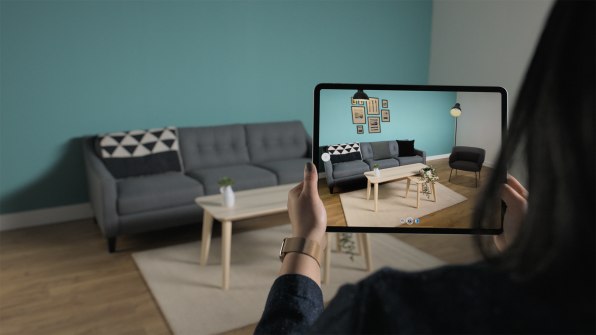
The new iPad Pro's new lidar scanner—which sits with the cameras on the back in an iPhone eleven-like bump—can rapidly find objects (and people) upward to five meters away and determine how they're positioned in relation to each other. That'southward a boon for AR applications, which demand to have an agreement of your real-world environment then they tin lay digital imagery on top of information technology. The implications that arrive beyond the new iPad Pro: Our own Mark Sullivan has reported that Apple plans to add similar technology to the side by side iPhone. When and if Apple releases AR glasses, lidar could also be a major part of the recipe. (The tech might as well assistance with photographic effects—like background-blurring bokeh—simply is used only for AR in the new iPad Pro, which limits portrait-fashion photos to its front-facing camera.)
As of now, with existing apps written using Apple's ARKit framework, lidar's impact is noticeable but not transformative. With the onetime iPad Pro (or an iPhone), orienting AR apps involves an inelegant procedure of waving the tablet around while it displays letters coaching you lot to proceed your jostling until it's identified flat surfaces. Thanks to lidar, the new iPad Pro dispenses with this rigmarole and is set to go almost instantly. This speedup certainly enhances apps such as Apple'south Measure out (a virtual tape measure) and iScape (a landscaping app that lets you plant digital foliage in your 1000).
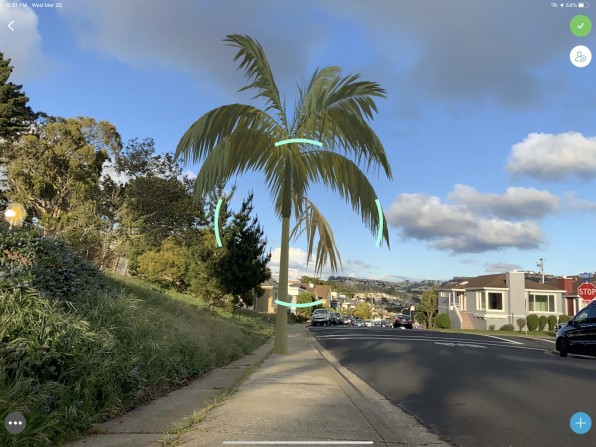
But the real reason to be excited most lidar is its potential to unleash new features in apps that are written specifically to take reward of it. Apple has been teasing several such products as part of its iPad Pro rollout. A new version of Ikea Place, for example, will browse your room, identify the furnishings you lot've already got, and suggest new items to complement them. And a game chosen Hot Lava volition plop down virtual patches of lava for you lot to jump over, positioning them with more than sophistication than existing AR apps, which tend to more often than not find the almost obvious surfaces such as tabletops and floors.
What AR needs most of all are killer apps that teeming masses of people desire to use. The app industry is withal struggling to come up with them, which is why the iv-year-oldPokémon Get remains the category'south go-to example. Lidar may provide some of the necessary inspiration. Ultimately, I'g more excited about the technology in phone form than on a tablet: The 1.four-lb. 12.9″ iPad quickly got tedious when I held information technology up for extended AR sessions. (The ane-lb. 11″ model would be less of a handful.)
Hither comes the cursor
Full disclosure: After using diverse iPads equally chief computing devices for more than eight years, I've never craved mouse or trackpad input. When I reviewed the original iPad Pro in 2015, I even helpfully pointed out that "THE LACK OF A MOUSE IS THE WHOLE Bespeak!!!" (yes, in bold caps with three exclamation points). I remain grateful that Apple tree devoted its intellectual majuscule to edifice a impact-first platform rather than trying to split the difference with the PC, as Microsoft's Surface has ever done, to uneven result.
But . . .
Having spent a little time with the iPad Pro and Apple's Magic Trackpad, I'm sold on the new cursor support. It'southward available for all iPads in the latest iPadOS update, merely leaves me even more impatient for the iPad Pro'southward trackpad-equipped Magic Keyboard to show up in May.
Rather than grafting the Mac's venerable pointy cursor onto the iPad interface, Apple rethought what mouse-style input should be like in a mostly affect environment. The cursor is a circle—evoking a fingertip—that morphs with adroit grace equally you slide information technology over elements such as buttons. It'south one of the most polished pieces of software functionality that Apple or anyone else has introduced lately, and the first major payoff of Apple's determination final year to rebrand the iPad's version of iOS as iPadOS.
Using the Magic Trackpad—a jumbo-size external Bluetooth model—I selected jumbo blocks of text, used two fingers to scroll through documents, and right-clicked to accomplish heretofore inaccessible menus in spider web apps. Everything just worked. (Well, 99% of everything—the Todoist app didn't always register clicks on its checkboxes; an update is in development.) Developers that want to shape-shift the cursor in ways tailored to their apps will be able to do and then through software updates. That customization seems like it will exist particularly of import for productivity apps; Apple itself plans to release new versions of its Pages, Numbers, and Keynote soon.
Historically, Apple has oft been at its all-time when it's ignored pleas for new features until information technology's felt like it has something that's fully broiled. One classic example: cut and paste, which didn't come to the iPhone until two years after the smartphone'south 2007 release. In the case of mouse-cursor support, Apple is delivering something that people began asking for close to a decade ago, when the iPad was new. But we're getting the kind of carefully considered support the platform deserves. And it's here for every iPad that tin run iPadOS thirteen, non simply the new iPad Pro.
Source: https://www.fastcompany.com/90481033/the-new-ipad-pro-is-a-minor-upgrade-with-intriguing-implications
Posted by: phillipsforand.blogspot.com


0 Response to "How To Upload Movies To Ipad Pro"
Post a Comment